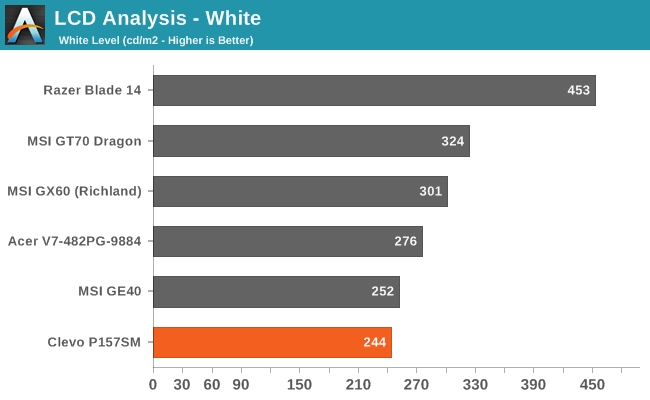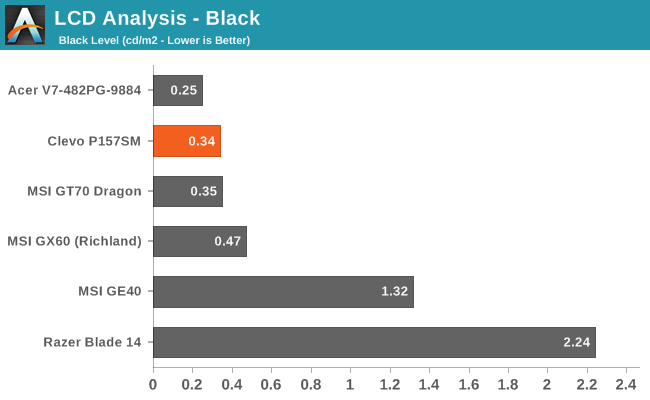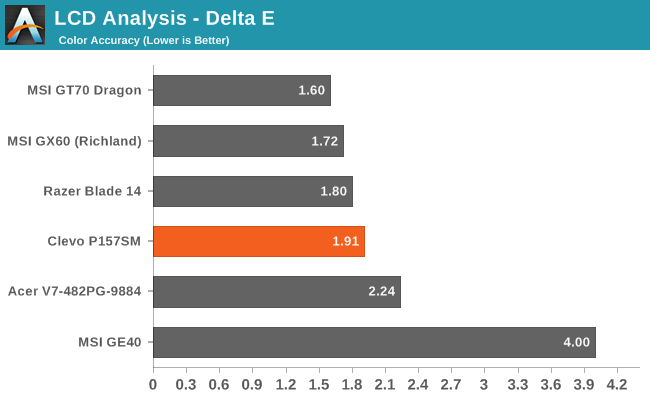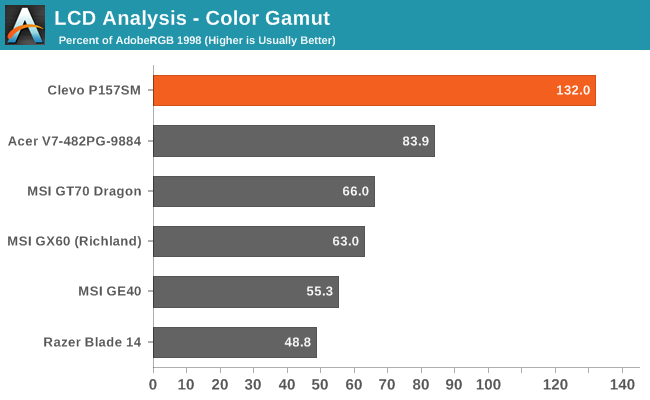Mythlogic Pollux 1613 / Clevo P157SM Review
by Jarred Walton on August 30, 2013 12:00 AM ESTMythlogic Pollux 1613 / Clevo P157SM LCD Analysis
The P157SM we received comes with the venerable AU Optronics B156HW01 v4, one of the best (if not the best) TN laptop panels around. It has a 95% NTSC color gamut, which translates into a much larger gamut than you will generally need. Of course, a wide gamut can actually end up creating seriously oversaturated colors if you’re working in an sRGB color space, but considering the poor quality of most laptop displays I prefer this panel to the other TN alternatives.
A good IPS panel would still be the best solution, and one that’s factory calibrated would be almost more than I could hope for. Mythlogic does provide a free “professional monitor color calibration” with the Pollux 1613, using a Spyder3 colorimeter, so you should at least get reasonably close to the calibrated results we show below, which is great. Unfortunately, the color profiles don’t necessarily work in all applications – a profile stored in a monitor’s LUT (Look Up Table) would be the right way of doing things, but I’m not sure I’ve ever seen a laptop other than the MacBook Pro Retina that takes such an approach.





There are two complaints I have with the display: it’s not able to get as bright as I’d like for use brightly lit environments, and with no calibration or profile loaded, the DeltaE on the B156HW01 v4 ends up being a rather poor 20.44 on average, with some colors hitting as high as 30 dE. Calibration thankfully fixes most of the problems, and we end up with maximum spikes of 5.3 and an average of 1.91. And as mentioned above, Mythlogic will calibrate your laptop to its specific display (using a Spyder3 colorimeter) for free; many of the other boutiques charge $50 or more for this service.
Contrast could also be better, as 700:1 isn’t as good as what we’re seeing with the new AHVA/IPS panels. Still, it’s a pleasant panel to use in general, and imaging professionals will be well served by the colors. Viewing angles, as mentioned earlier, are also about as good as you can expect from TN – a little washed out from above and below, but nowhere near as bad as something like the MSI GE40 panel.


_thumb.jpg)
_thumb.jpg)
_thumb.jpg)
_thumb.jpg)
_thumb.jpg)









47 Comments
View All Comments
JarredWalton - Sunday, September 1, 2013 - link
What he said for the GPU. As for mSATA, there are two mSATA positions in the P157SM, so you can use two mSATA and two 2.5" HDD/SSDs. No idea on the cooling and turbo stuff for MSI, but I'd guess they're all the same in terms of features; maybe someone else has a better answer.For the performance differences, it could be drivers, it could be firmware optimizations, and it could be differences in maximum sustained Turbo (due to differences in cooling). On the desktop we're at the point where if you use the same CPU and GPU, performance is basically identical within a few percent, but on laptops there's still a lot more variation. Hope that helps.
Freakie - Monday, September 2, 2013 - link
Hey Jarred, you wouldn't happen to be getting an ASUS N550 in anytime soon, would you?JarredWalton - Monday, September 2, 2013 - link
I'll request one, but at present no laptop from ASUS is in route.landsome - Tuesday, September 3, 2013 - link
I am still a bit puzzled by the inability of the single-fan solution of the MSI GT series to do well by Haswell+GTX780M. I have an old MSI GT663R and it keeps a 920XM @ 3.2GHz and a 7970M under control in prime+furmark, no throttling, CPU at 95C max, GPU at 87C. With a 820QM and the same vid card, it's around 85C+85C in the same scenario - and Clarksfield is a hot processor. I also owned an HP 8740W, and its single-fan solution was capable of cooling well a 920XM and a Quadro 5000M (also prime+furmark).So why this sudden weakness with the GT60 and GT70? (Also worth noting that the dual heatsinks on my GT663R are much heavier than the dual heatsinks on the Clevo P150EM I owned for a short while, while the fan is bigger and more potent than any of the two Clevo fans, though the Clevo did cool well too.)
JarredWalton - Tuesday, September 3, 2013 - link
Haswell is the same process as Ivy Bridge, so it's not really any cooler running -- it's just able to go into lower power states more quickly, more or less. In fact, it may run slightly hotter (not sure), all things considered. At present, the GT70 isn't throttling -- it's just running hotter than we'd like. Is it worth considering? For the right price, and if you like the styling more than the Clevos, sure. I don't think it's better, and you can get heavier copper heatsinks for Clevos from some vendors (XoticPC for instance), but go with what you think is best.paulfp - Saturday, December 14, 2013 - link
Battlefield 4 in Clevo http://j.gs/3B5Krickstones - Wednesday, April 16, 2014 - link
I have an order with Sager for a NP8258 (= Clevo P157SM). The original LCD panel was the 95% NTSC Gamut matt finish panel. I was just notified by Sager that this panel is no longer available due to "quality problems".Does anyone have information on what the problems are with this panel? Its been around for a pretty long time now, I don't know why they should begin experiencing quality problems at this point...
Also, I replaced this panel with the standard FHD matt finish panel. Anyone know if this this is a decent LCD? It was only $35 less than the 95% NTSC Gamut. I loaded this laptop up to the gills and am paying a lot of dough for it. I really don't want to be stuck with a subpar LCD.